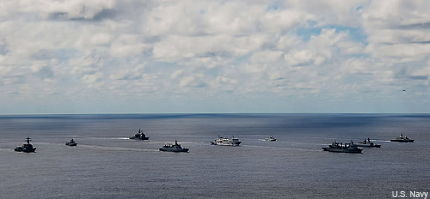ONR demos advanced electronic warfare system at RIMPAC
The EWBM allows sailors to react faster to incoming threats and optimize the use of electronic warfare assets.

A multinational task force arrives at Pearl Harbor for RIMPAC 2014.
Navy sailors have demonstrated a new electronic warfare system that could change how ships defend themselves, according to a release from the Office of Naval Research.
Having undergone its most extensive tests at the 2014 Rim of the Pacific exercise in July, ONR’s Electronic Warfare Battle Management for Surface Defense was successfully demonstrated on several U.S. and coalition ships, ONR said.
The system, designed with the intent of achieving information dominance, is based on the use of electronic warfare – using the electromagnetic spectrum to attack or defend against enemies.
“Electronic warfare is about controlling and using energy while taking away our adversary’s ability to use it,” David Tremper, ONR program officer for electronic warfare, said in the release. “With this system, sailors and Marines will be able to exchange spectrum and threat information between platforms so they can make more informed decisions in situations where time and accuracy are crucial.”
EWBM represents a fusion of different assets to provide a real-time networked capability to assess and coordinate electronic warfare assets, according to a Navy fact sheet. The system is envisioned as a data exchange architecture system that would manage sensor data, situational awareness and non-kinetic countermeasures.
Using automation software, the system would allow sailors to remotely coordinate countermeasures against incoming threats faster than traditional voice communications and reduce the need for kinetic countermeasures, the Navy said.
“Our forces need to be able to deny adversary sensors the ability to track our ships, but if that fails, they need to be able to rapidly coordinate the optimal countermeasures across multiple ships and aircraft which will provide protection to everyone in the line of fire,” Tremper said. “This system provides our sailors and Marines the tools they need to do just that.”
Naval officials also have said that the ability to disable the electronic systems of adversaries also could save on using conventional, kinetic weapons.
The EWBM for Surface Defense would be responsible for most of the management of electronic warfare, including initial assessments of EW asset and capability readiness, and coordinating data exchange across different security and operational domains. For instance, the system would allow personnel on ships and aircraft to share digital information about enemy sensors and radar.
The system would also enable the coordination and optimization of EW assets against potential and confirmed threats by calculating the most effective formations and allocation of resources.
NEXT STORY: Army awards $89 million contract for C3 support

